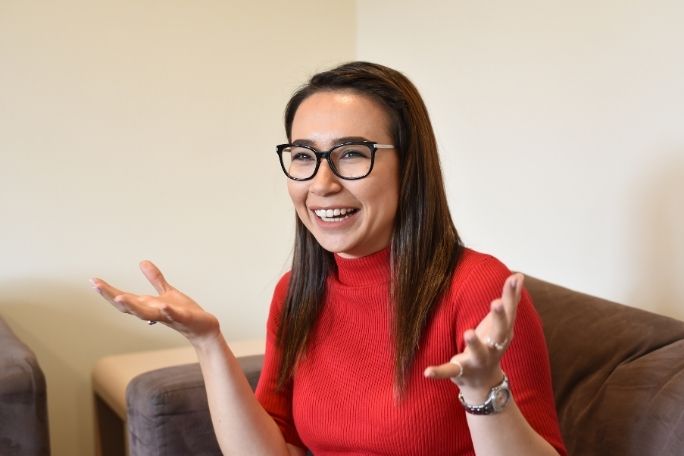Lesson summary
In this lesson, students will be guided through a series of scenarios, based on the real experiences of a young female refugee, Shabnam. Shabnam is a 24-year old Hazara woman from a town near the border of Pakistan and Afghanistan, who arrived in Australia as a 14-year-old refugee in 2009. This lesson guides students through a process of brainstorming tangible and practical positive actions they could take to support Shabnam (or a refugee or person seeking asylum like her) to achieve her potential and overcome the challenges explored in the lesson.
Learning intentions:
Students will...
- increase their awareness of, and empathy for, the challenges faced by refugees building a new life in Australia.
- increase theirunderstanding of the lived experiences of refugees in Australia.
- identify and explore tangible and practical positive actions they can take to support refugees to overcome their challenges.
Success criteria:
Students can...
- make a range of social and ethical decisions based on a given scenario
- work in teams to make a decision
- justify their decisions based on the expected outcomes
Lesson guides and printables
Lesson details
Curriculum mapping
Australian curriculum content descriptions:
Year 8 Civics and Citizenship:
- Citizenship, diversity and identity: How national identity can shape a sense of belonging in Australia’s multicultural society (ACHCK067)
- Different perspectives about Australia’s national identity, including Aboriginal and Torres Strait Islander perspectives, and what it means to be Australian (ACHCK066)
- Analysis, synthesis and interpretation: Critically analyse information and ideas from a range of sources in relation to civics and citizenship topics and issues (ACHCS070)
- Problem solving and decision-making: Appreciate multiple perspectives and use strategies to mediate differences (ACHCS071)
- Communication and reflection: Reflect on their role as a citizen in Australia’s democracy (ACHCS074)
Year 9 Civics and Citizenship:
- How ideas about and experiences of Australian identity are influenced by global connectedness and mobility (ACHCK081)
- Analysis, synthesis and interpretation: Critically evaluate information and ideas from a range of sources in relation to civics and citizenship topics and issues (ACHCS084)
- Problem solving and decision-making: Recognise and consider multiple perspectives and ambiguities, and use strategies to negotiate and resolve contentious issues (ACHCS086)
- Communication and reflection: Reflect on their role as a citizen in Australian, regional and global contexts (ACHCS089)
General capabilities: Ethical understanding, Intercultural understanding, Critical and creative thinking, Personal and social capability
Relevant parts of the Year 8 achievement standards: Students identify the diverse belief systems in Australia and analyse issues about national identity and the factors that contribute to people’s sense of belonging. They explain different points of view on civics and citizenship issues. When planning for action, students take into account multiple perspectives, use democratic processes, and develop solutions to an issue. Students develop and present reasoned arguments on civics and citizenship issues using appropriate texts, subject-specific language and concepts. They identify ways they can be active and informed citizens in different contexts.
Relevant parts of the Year 9 achievement standards: Students analyse a range of factors that influence identities and attitudes to diversity. They reflect on how groups participate and contribute to civic life. They compare and account for different interpretations and points of view on civics and citizenship issues. When planning for action, students take into account multiple perspectives, use democratic processes, and negotiate solutions to an issue. Students develop and present evidence-based arguments on civics and citizenship issues using appropriate texts, subject-specific language and concepts. They analyse ways they can be active and informed citizens in different contexts.
Unit of work: Our Stories – Building a new life in Australia – Years 8 & 9
Time required: 60 mins
Level of teacher scaffolding: Medium – teacher reads through a range of scripted scenarios and facilitates class discussion
Resources required
- Student Worksheet – one copy per student
- This Teacher Worksheet or the Our Stories Situation Script – one teacher copy
- Equipment to project an online clip for the whole class to watch
- A stopwatch, timer app or whiteboard countdown
Skills
- Collaboration
- Communication
- Community engagement
- Critical thinking
- Cultural understanding
- Empathy
- Ethical understanding
- Global citizenship
- Problem solving
- Social skills
Additional info
These lessons have been created in partnership with Stand Up: Jewish Commitment to a Better World to be used alongside their Our Stories project.


Welcome back!
Don't have an account yet?
Log in with:
By signing up to Cool.org you consent and agree to Cool's privacy policy to
store, manage and process your personal information. To read more, please see
our privacy policy here(Opens in new tab).
Create your free Cool.org account.
Many of our resources are free, with an option to upgrade to Cool+ for premium content.
Already have an account?
Sign up with:
By signing up to Cool.org you consent and agree to Cool's privacy policy to
store, manage and process your personal information. To read more, please see
our privacy policy here(Opens in new tab).